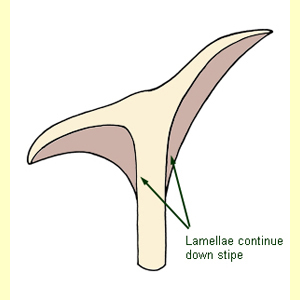
Lamellae attachment can be observed by turning over the fruit-body and looking at the points where the lamellae join the stipe. In addition, a longitudinal cross section of the fruit-body is useful to expose the lamellae and see the attachment side-on. Care is needed when making the cross section so as not to tear the lamellae away from the stipe, thus giving them the appearance of being free when, in fact, they are adnexed or adnate.
Lamellae attachment is best observed on mature fruit-bodies, where the pileus has expanded. On over-mature fruit-bodies, where the pileus begins to shrivel or turn upwards, the lamellae can pull away from the stipe. The presence of thin, longitudinal lines at the extreme apex of the stipe can be a sign that the lamellae have become detached.
If there is no stipe, or the stipe is rudimentary, do not enter any states for lamellae attachment.
Choose this state if: the lamellae are decurrent, extending down the stipe. This occurs in one of several ways. When the lamellae are quite triangular in shape, so that they are much broader near the stipe, the lower edges are at an acute angle to the stipe. When the pileus is uplifted (as when it is infundibuliform) this also lifts up the sometimes quite narrow lamellae, so that they make an acute angle with the stipe at the point of attachment. Lamellae can also be decurrent when the pileus is plane, with the flesh much thicker near the stipe than at the pileus margin, and again the lamellae will make an acute angle with the stipe at the point of attachment. In arcuate lamellae, the lamellae edges are curved like an arch, but still with a decurrent portion extending down the stipe at the point of attachment.
